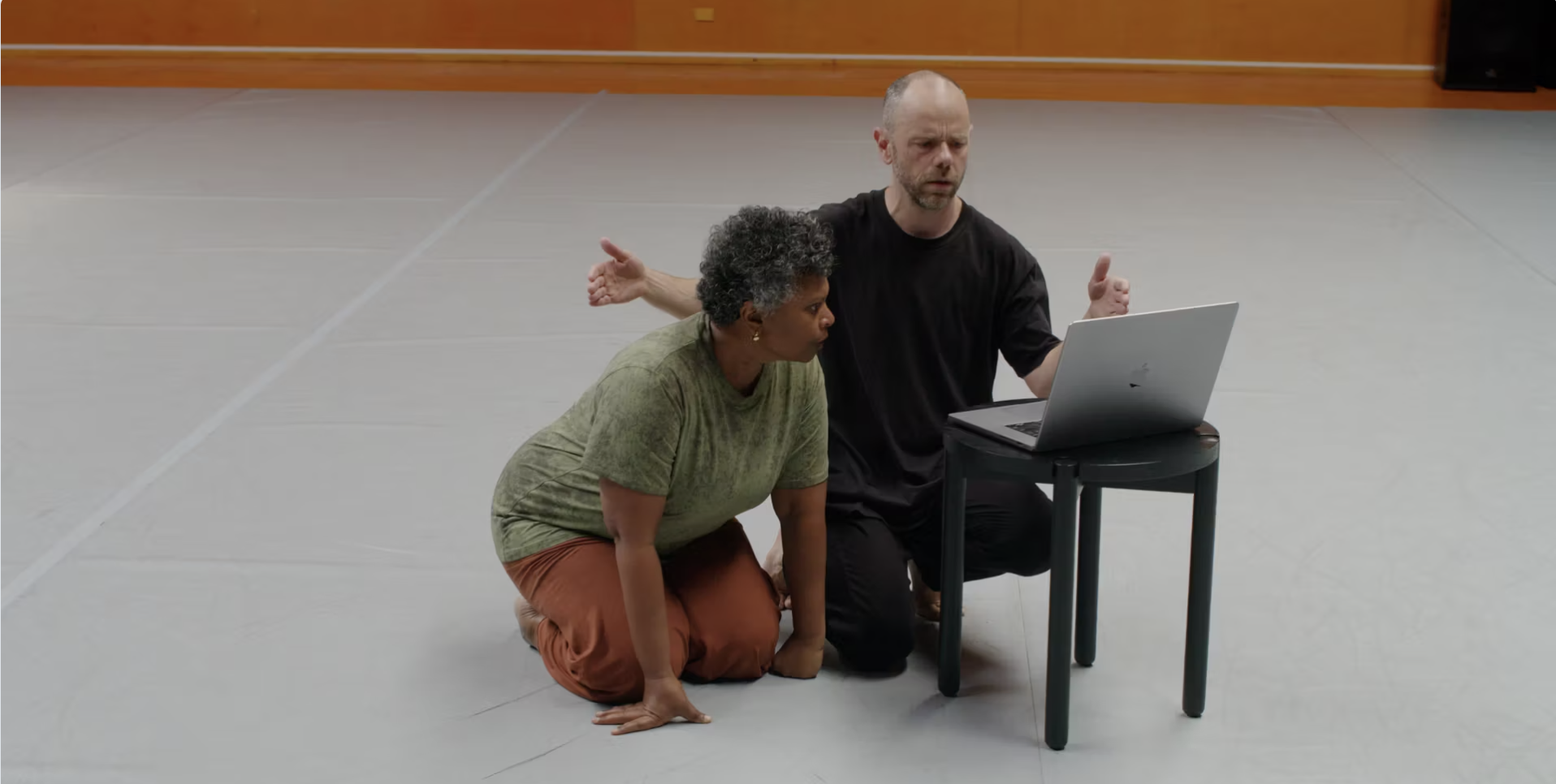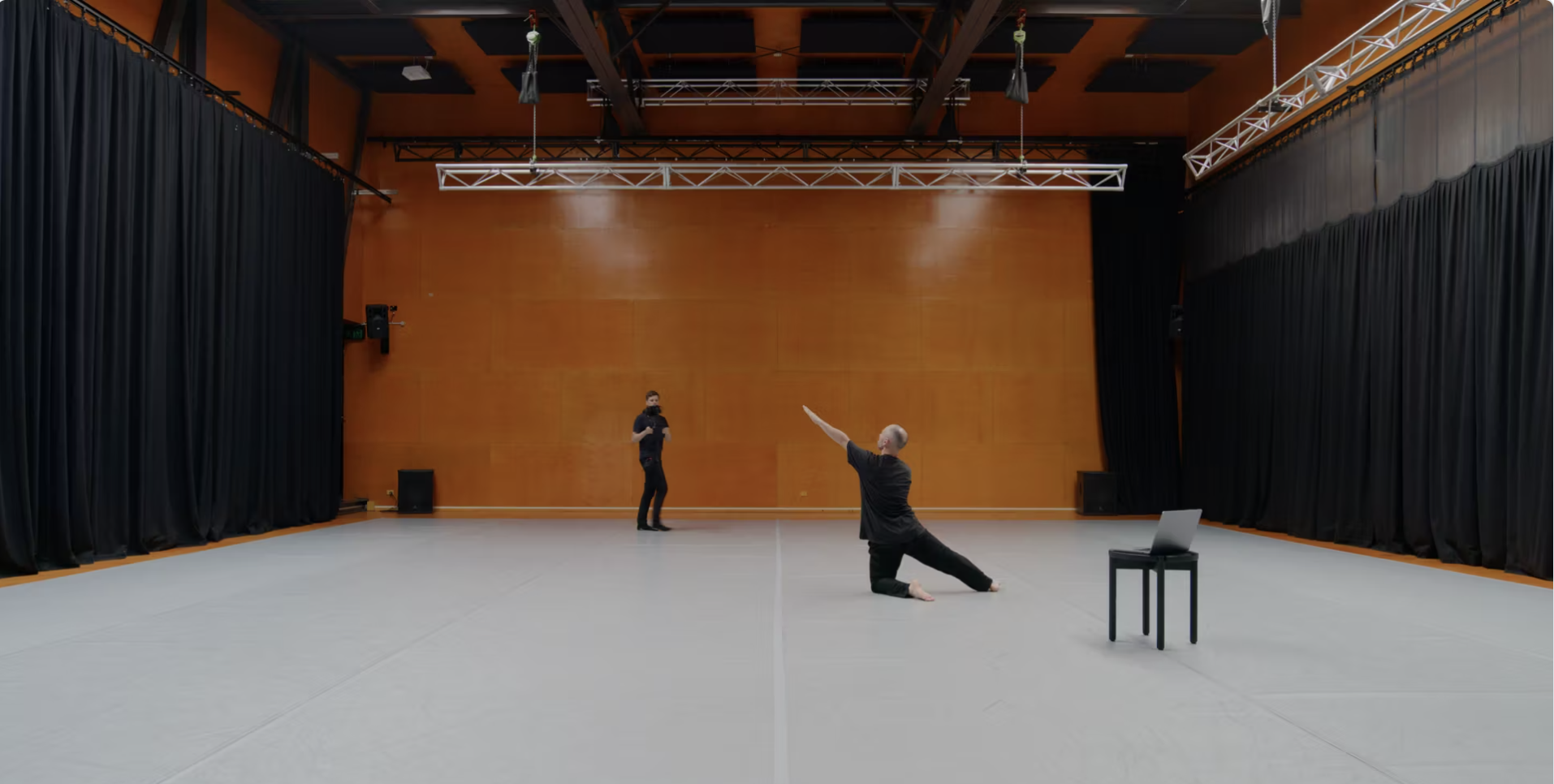Reenactment
Frank Van Straten fellowship Progress report by amaara raheem
Amaara and Antony looking closely at the past. (Chunky Move studios, December 2023).
C.o.r.r.u.p.t.e.d 2, choreographed in 1998 by founder and then Artistic Director of Chunky Move Gideon Orbazenek, physically depicted corrupted data in the digital age. Generally, data corruption occurs when a file containing data produces unexpected results when accessed. Error. Alteration. Unusable. Overwriting. System crash. Malfunction. Some of the words associated with data corruption and also this dance work, which led Dance Australia to declare: “Chunky Move is heading full-on into the 21st century.”
In September 2023 when I was awarded the Frank Van Straten Fellowship the first choreographic move I made was to invite current Artistic Director and co-CEO of Chunky Move Antony Hamilton to reenact a section of an early work of Chunky Move. Which of course brought up the question ‘what (or how) is reenactment?’
Screenshot of the video C.o.r.r.u.p.t.e.d 2 (1998) now in the Australian Performing Arts Collection at Arts Centre Melbourne. Antony reenacted this section of the dance watching this grainy video.
One way to think about reenactment, is a process by which to create a signifier that emphasises the pastness of an event. Or as Stefan Kaegi co-founder of theatre company Rimini Protokoll writes, to “recall events whose aftershocks are felt to this very day”.
Antony chose C.o.r.r.u.p.t.e.d 2. He didn’t dance in the original staging of the work but was part of its re-staging in 2002. Antony hadn’t performed the work in over 20 years but even as we first talked about it in the small, fluorescent lit research room at Hamer Hall, the ghosts of the movement leaked out of his body, like smoke.
After an initial viewing of C.o.r.r.u.p.t.e.d 2, Antony and I had a week of rehearsal at Chunky Move studios in Sturt St, Southbank. These studios are in and of themselves an archive. Their very floors and walls hold so much history of this company’s work. So many movements mapped into the air; the space between us. We entered a precise reenactment of a section of the movement together. Me observing and notating the process. Antony reenacting the choreography. We watched the video repeatedly and watched the movements arise out of his body. With each repetition small details returned. In doing so, the point was less to re-stage the entirety of a dance work that happened in 1998 but to explore what happens when Antony - with his unique history of Chunky Move - constructs the past in the present.
It seemed inevitable that James Wright was the right person to record the reenactment. In my initial email to James I wrote:
“Antony and I have been spending some time in the archive, and we've been talking about who would be best to make a copy of the copy! I'm particularly interested in you because of your own history with CM but also, looking at your website, your work in making so many records of dance / performance. The eye behind the many 'I's.”
James Wright has been documenting Chunky Move’s dance works for many years. He’s videoed most of the works choreographed by Antony Hamilton and the artistic director before him, Anouk van Dijk. To James’ question what is it that we’re trying to record I replied:
“Antony and I met yesterday in the studio and what we've come to is that we'd like you to video not so much a finished outcome - as a staged polished dance work - but rather the process of remembering a dance work, in rehearsal. The movement material is about 2 mins long but Antony is learning it from video and this is what we'd like to capture: the back and forth of remembering, forgetting, and the repetitive motion of returning - to something that is then changed in the act of re-doing - maybe what I mean is, I’d like you to capture the process of complicating time.”
James Wright making a record of the record.
I also invited sonic thinker, artist and researcher Dr. Jordan Lacey to come into the studio and audio record Antony in rehearsal. I wanted to hear the footfall, the crack in his knee every time he crashed sideways. To c.o.r.r.u.p.t. the viewing experience as it were.
Or more importantly to listen to the archive. And then to listen better.
Jordan Lacey testing audio recording equipment to capture the ghostly sounds of Antony’s movement.
What is my role here, as the Frank Van Straten Fellow?
My role is multifarious and still evolving. However in this instance, it was the glorious and utterly unique situation of being the sole witness of this reenactment process. I stood in the carpeted room of the Arts Centre archive as amidst boxes and books wisps of movement escaped from Antony’s body-memory. I was reminded of choreographer Yvonne Rainers famous words, ‘the mind is a muscle’. Then I witnessed Antony return again and again to the video, weaving certain moves back together from this blurry, grainy, decomposing film and also, from a different image - his inner eye. A landscape of memory held in muscle, bone and flesh. At first full of holes but then over time, I witnessed how the holes became whole.
My role here is to contribute methodologies that are conversational, relational, social and embodied rather than a historical analysis. To perceive Chunky Move’s archives through approximations, lived experiences, spidery webs, forgetting and remembering, through physical imagination, facts-as-fiction. To explore how a dance collection acts as prompts for stories, and how each archival image also holds stories in and of themselves.
The reenactment video will be available soon!
In the meantime here’s an interview I recorded with Chris Thompson for Vision Australia Radio, in the archive room itself. Pouring over files and boxes and remembering our past - mine and Chris that is - for we met in those early years of the 90’s, when Chunky Move first began operation; when Chris Thompson was Artistic Director of St Martin’s Youth Arts Centre where - aged nineteen - I first stepped onto the creaky boards of a theatre and felt those hot stage lights burn so brightly into my eyes as I fell down, down, down, like Alice, into Wonderland(s).
Thank you Claudia Funder and Arts Centre Melbourne for this unique opportunity. To all at Chunky Move and especially Antony Hamilton for your support and generosity with this experiment. To Frank Van Straten for enabling performing arts history to dance into the future.



